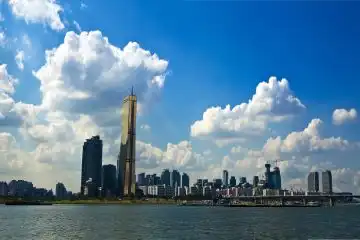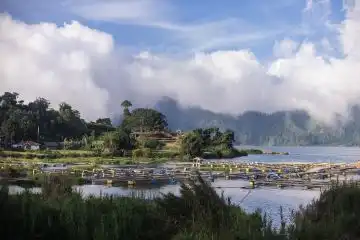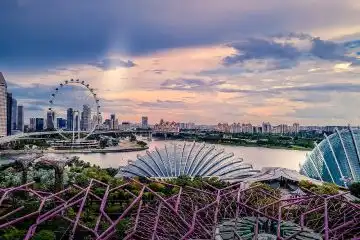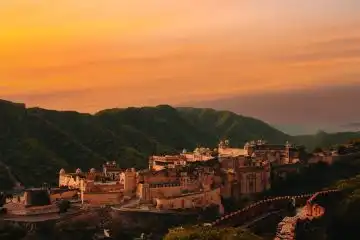Experience the unique blend of tradition and modernity in Seoul
Seoul, is the dynamic capital of South Korea. The perfect blend of tradition and modernity in Seoul in which past and future intertwine seamlessly. Witness the centuries-old palaces standing beside towering glass skyscrapers. Explore the bustling markets thriving alongside high-tech shopping malls, and street food stalls coexisting with Michelin-starred restaurants. In short, Seoul offers a captivating experience that reflects both its deep-rooted traditions and its cutting-edge modernity. Whether you are a history buff, a tech enthusiast, or a foodie, Seoul has something for everyone.
1. Gyeongbokgung Palace: A Window into the Joseon Dynasty
One of the best ways to experience the tradition and modernity in Seoul is by visiting Gyeongbokgung Palace. Built in 1395, this grand palace serves as a striking reminder of the Joseon Dynasty's legacy. Walking through its ornate gates and serene courtyards, you'll feel transported back in time. Yet, just beyond its walls, you'll see the city's modern skyline. That symbolizes Seoul's ability to preserve its heritage while embracing progress. The changing of the guard ceremony, held daily, firstly adds to the immersive historical experience. It further offers a glimpse into royal customs. Exploring the National Palace Museum and the nearby Folk Museum further enhances visitors' understanding of Korean history.
2. Bukchon Hanok Village: A Glimpse of Traditional Korean Life
Nestled between Gyeongbokgung and Changdeokgung Palaces, Bukchon Hanok Village is a charming neighborhood. It is filled with traditional Korean houses (hanok). Despite its old-world ambiance, the village is also home to trendy cafes, art galleries, and boutique hotels. That firstly makes it a perfect example of Seoul's fusion of old and new. Walking along its narrow alleys, you can witness residents living in these historic homes. You can meanwhile see tech-savvy travelers documenting their visits on social media. That further showcase how the tradition and modernity in Seoul coexist harmoniously. Participate in a hanbok rental experience and explore tea houses. That meanwhile allows visitors to immerse themselves even deeper into Korean traditions.
3. Dongdaemun Design Plaza: Where Innovation Meets History
Designed by the renowned architect Zaha Hadid, Dongdaemun Design Plaza (DDP) is a futuristic landmark. That firstly represents Seoul's modernity. Located in the historic Dongdaemun area, this is an architectural marvel. It hosts fashion shows, art exhibitions, and tech events. That meanwhile highlighting the city's creative spirit while paying homage to its commercial heritage. The vibrant night market outside the plaza provides a stark contrast. That further offers everything from street food to affordable fashion. Above all, it blends the old commercial culture with the new. You can also refer the details about exploring the astonishing beauty of Prague and plan a trip. Visiting the area at night allows tourists to experience its illuminated beauty and bustling shopping scene. That remains active until the early hours of the morning.
4. Jogyesa Temple: Serenity in the Heart of the City
Amid Seoul's fast-paced urban landscape, Jogyesa Temple stands as a peaceful sanctuary. As the center of Korean Buddhism, this temple features vibrant lantern displays and intricate wooden carvings. Despite being surrounded by modern skyscrapers, its tranquil atmosphere offers a spiritual retreat for both locals and tourists. Visitors can participate in meditation sessions or witness Buddhist ceremonies, gaining insight into traditional spiritual practices. That meanwhile continue to thrive amid the city's rapid modernization. During the annual Lotus Lantern Festival, the temple becomes a spectacular display of glowing lights. That meanwhile attracts thousands of visitors admiring the blend of ancient customs and contemporary celebrations.
5. Myeongdong: A Shopping Paradise Blending Old and New
Myeongdong is a bustling district where tradition and modernity in Seoul collide beautifully. While luxury brands and global retailers dominate the streets, tucked-away alleys reveal centuries-old street food vendors. That are selling traditional Korean snacks for example tteokbokki and hotteok. This contrast further makes Myeongdong a must-visit for shopaholics and food lovers alike. Even in the midst of digital billboards and flashy advertisements, there are small shops. That are selling hanboks and herbal remedies reminding visitors of the district's historical roots. Beauty lovers can also explore both modern K-beauty stores and herbal skincare shops. That have been passed down through generations.
6. Insadong: The Cultural Hub of Seoul
For a deeper cultural experience, Insadong is the place to be. This neighborhood is known for its antique shops, calligraphy stores, and tea houses that preserve Korea's artistic traditions. However, modern art galleries and hip cafes have also found their place here. That firstly makes Insadong a perfect blend of past and present. The bustling street performances featuring traditional dance and contemporary busking acts further highlight the cultural duality of this iconic area. Art lovers will appreciate the mix of classic calligraphy stores and contemporary mural paintings. That further adorn the alleyways.
7. Namsan Seoul Tower: A Cityscape View Like No Other
For a panoramic view of Seoul's skyline, head to Namsan Seoul Tower. While ascending, you'll notice the stark contrast between the lush Namsan Park below and the sprawling cityscape beyond. Whether you visit during the day or at night, the view from the top showcases the incredible juxtaposition of Seoul's historic and futuristic elements. Visitors can also leave love locks on the fences. It is a modern romantic tradition that adds a contemporary touch to this historically rich landmark. Dining at the revolving restaurant inside the tower adds another dimension to the experience.
8. Han River Parks: Traditional Relaxation in a Modern Metropolis
Seoulites escape the hustle and bustle of the city by visiting the scenic Han River Parks. Whether you're biking, picnicking, or enjoying the view, these parks offer a refreshing contrast to the urban environment. Traditional music performances and modern light shows frequently take place here, further emphasizing Seoul's cultural duality. Boat cruises along the river provide an immersive experience. That further allow visitors to witness the blend of historical bridges and modern skyscrapers. At night, drone shows and music festivals bring a contemporary vibrancy to this peaceful retreat.
9. Korean Traditional Markets vs. High-Tech Malls
Seoul's shopping scene perfectly illustrates the balance between tradition and modernity in Seoul. The Namdaemun and Gwangjang Markets remain hubs for traditional food and handmade goods. But, futuristic malls for example COEX and Lotte World Tower redefine the shopping experience with AI-powered services and digital innovations. There is a seamless integration of mobile payment systems in traditional markets. That further highlights how technology enhances historical commerce rather than replacing it. Traditional market food tours allow visitors to taste classic dishes while learning about their historical significance.
10. K-Pop and Traditional Music: A Harmony of Sounds
Seoul's music scene is another example of how the city blends its past and future. While K-pop dominates the global stage, traditional Korean music, known as gugak, continues to thrive. Many cultural centers and performances firstly celebrate both genres. That meanwhile allows visitors to appreciate the city's rich musical heritage alongside its modern pop culture. The National Gugak Center regularly hosts performances that further showcase Korea's classical sounds. While the streets of Hongdae pulse with the energy of K-pop buskers. Attending both a traditional performance and a K-pop concert offers a full appreciation of Seoul's musical diversity.
11. Traditional Korean Cuisine Meets Contemporary Dining
Seoul's food scene is a delicious mix of old and new. It goes from centuries-old hanjeongsik (traditional Korean full-course meals) to cutting-edge molecular gastronomy. The city's culinary landscape firstly showcases its deep respect for tradition while embracing innovation. Michelin-starred restaurants and local eateries alike highlight this harmonious blend of tradition and modernity in Seoul. Food festivals in Seoul often feature both heritage dishes and contemporary culinary experiments. That further ensure that traditional flavors remain relevant in a rapidly evolving food scene.
Conclusion
Seoul masterfully balances its past and future, offering visitors a unique journey through time. It goes from historic palaces and temples to state-of-the-art skyscrapers and high-tech experiences. In other words, tradition and modernity in Seoul coexist in perfect harmony. Whether drawn to its rich cultural heritage or its forward-thinking innovations, Seoul is a perfect destination. That never ceases to amaze anybody. It further ensures every visitor leaves with a deeper appreciation of both history and progress.












